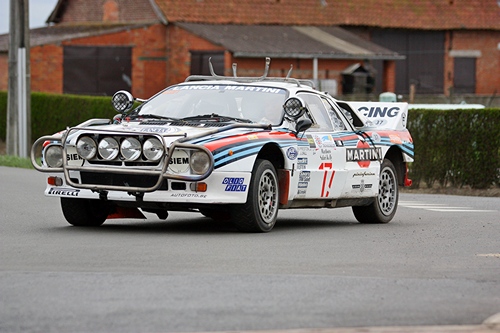Background
When the Fiat Group decided that they needed a new rally car in the early 1980s, they already knew that the FIA would bring in the Group B regulations from 1982 with full implementation in 1983. They had several possibilities ranging from a V6 Fiat 131 to a Stratos-like version of their X-19 sports car.
Eventually they settled on a sports car, which would be known as the Lancia 037 and the first car built specifically to the regulations offered by Group B, although throughout its entire life the car was exclusively rear wheel drive.
Taking advantage of the low weight restrictions and the ability to use composite materials, the car is loosely based upon the Lancia Monte Carlo. The centre tub of the road car was retained, the majority of the bodywork was replaced by composite materials, and the front and rear subframes were replaced by steel items which offered greater strength and allowed the engine to be switched from transversely mounted to longitudinally mounted aiding weight distribution and therefore handling.
The engine was supercharged throughout its life, as this removed the lag traditionally encountered with turbo charging. Originally having a 2 litre displacement offering 265BHP, by the time the car had reached its Evolution 2 stage this had increased to 2.1 litres and the BHP had increased to 325.
The car was a success straight out of the box with Walter Röhrl and Markku Alén, winning rallies as diverse as the Monte Carlo, the Acropolis and the Tour of Corsica. Lancia won the World Manufacturer’s Championship of 1983 while Miki Biasion was European Champion that year. Lancia would go on to take the Manufacturers Title again in 1984 and 1985.
This Car
Was originally driven by Antonio Bettega then shipped to Kenya for the Safari Rally and testing, before being driven by Vic Preston Jr on several Safaris, ultimately winning the African Championship.
The car is in the full Safari spec, as was competed in the East African Safari three times and was sponsored by Martini. This model won the 1983 World Championship outright and was the last 2-wheeled drive car to do so. It won the East African Safari Rally Championship in 1984 with Vic Preston Jnr driving and John Lyle navigating.
The car was in Lancia Museum from early 1990, before being purchased by its current owner.
Technical :-
Engine : four-cylinder, in-line, longitudinally mounted mid-engine, twin overhead camshafts, four valves per cylinder, 305 bhp, 1,995cc (E1), 325 bhp, 2,111cc (E2)
Induction : Bosch injection and Abarth supercharger
Body : spaceframe steel chassis with glassfibre & Kevlar bodywork, titanium roll cage
Suspension front :double wishbone with coil spring, single damper
Suspension rear : double wishbone with coil spring and twin dampers
Transmission : five speed gearbox/transaxle mounted behind engine driving rear wheels
Weight : 965 kg

